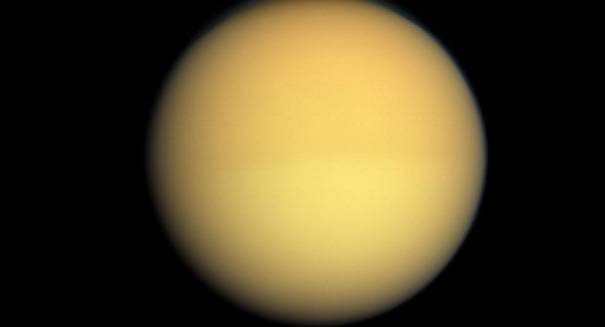
Cassini discovers evidence of Propylene on Titan.
You can find Propylene—the key ingredient in many plastics—almost anywhere. It exists in soap bottles, car bumpers, oh, and in the atmosphere of Saturn’s largest moon Titan.
“This chemical is all around us in everyday life, strung together in long chains to form a plastic called polypropylene,” Conor Nixon, a NASA planetary scientist and lead author of a paper, said in a statement. “That plastic container at the grocery store with the recycling code 5 on the bottom — that’s polypropylene.” The paper explaining the new research was published in the Sept. 30 issue of the Astrophysical Journal Letters.
NASA researchers had made this discovery using the Cassini orbiter’s Composite Infrared Spectrometer. NASA’s Voyager 1 spacecraft had found similar hydrocarbons in 1980, which had made the scientists wonder why they weren’t seeing the propylene. “It’s taken us 32 years, with a new spacecraft and a new instrument, to find it,” said Nixon. “It’s kind of a missing link.”
Propylene compounds on Earth are typically extracted from petroleum and processed into plastic consumer products. The process for producing it on Titan is a little different, however. The propylene as well as other hydrocarbons are produced when sunlight breaks down the methane in the moon’s atmosphere. That gives the atoms a chance to reassemble into molecules of varying complexity. Many scientists believe its chemical environment may hold keys to what Earth may have been like before oxygen was a dominant ingredient in the atmosphere. Nixon told NBC News. “Because there’s no free oxygen on Titan, it means this organic chemistry can just keep running and running and running like a huge natural experiment, and it can keep building more and more complex chemicals.”
Voyager is actually not sensitive enough to detect propylene, but it was able to find two other similar chemicals: propane and propyne, and their presence confirms the existence of propylene. What’s more, Titan’s atmosphere and lakes also contain variants of ethane and methane. The interaction of these hydrocarbons with the water ice that is believed to lie on Titans surface could lead to the formation of amino acids—the chemical building blocks of life.
“It is possible to produce amino acids,” Nixon said. “Those are the types of things we’ll be looking for in the future. We’re going up stepwise in complexity to determine how the chemical processes work on Titan.”
Leave a Reply